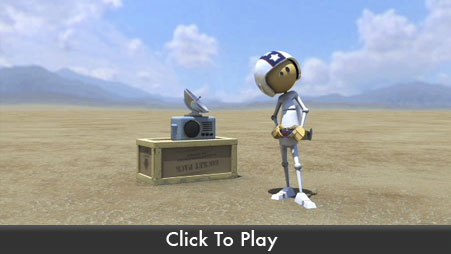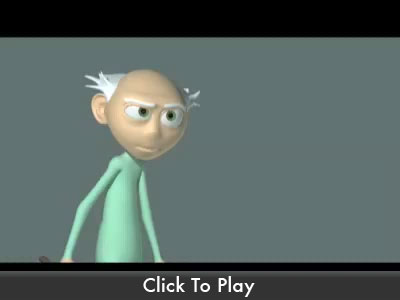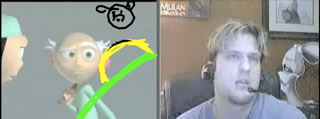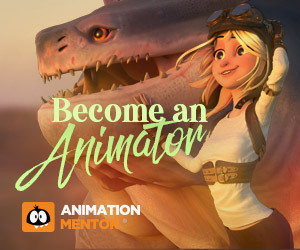Tim Granberg
Interview conducted by Eric Scheur
Here's a riddle for you: What do Lord of the Rings, Back to the Future, Star Wars, and the 11 Second Club have in common?
Answer: Trilogies!
That's right, my friend. With November's competition, Tim Granberg joins the likes of Doc Brown in the Old West and Frodo marching through Middle Earth. Tim's creative entry about a doctor who is a little past his prime earned him his third 11 Second Club win in 2008. (crikey! that's a full 25% of the year!) It's been fascinating to see Tim explore the ideas he pulls from the audio files and turn them into unique stories, all the while seeing his animation skills get stronger and stronger.
The hard work hasn't gone to waste, either. In late November, Tim was offered a job at Rhythm and Hues, one of the industry's most lauded character animation and effects studios. It just goes to show what persistence, patience, and perseverance can accomplish.
Tim has announced that, because of his new job, he will have to step back from competing for a while. Before his big departure, though, I am happy to say that we were able to talk one final time. Instead of addressing animation issues as we had in the last two interviews (June '08 and September '08), I took this opportunity to wrap things up with an overall look at Tim's accomplishments here at the club and his future in his career.
Congratulations again to Tim for all of his great work last year, and especially on his new job. Here's looking forward to a bright 2009! Who knows--it might not be long before we have our next three-time winner...
- Eric
There's big news since the last time we talked. You've recently been hired at Rhythm and Hues. Congratulations! Can you talk a bit about how it happened?
The process happened pretty fast, but it wasn't unlike the previous jobs I have been offered. This time my reel was mailed on a Wednesday, I got a call the following Tuesday, and interviewed on the next day (the day before Thanksgiving). The interview was me and some supervisors asking questions and looking at my reel. Personally, I never know what to say about my reel because, good or bad, I think it speaks for itself. Everything must have gone well enough because I started the following Monday. Although I like to think the process happened that quickly because of my "superior animation skills " or my "outstanding personality," I know it probably has more to do with having adequate enough skills and being instantly available, and I'm okay with that as long as it gets my foot in the door.
They did have my reel running while I was being interviewed, but there's really not much to say about my work beyond what you can see. For those who are interested, my demo reel can be viewed here:
I'll admit that it's not the best example of a reel, but I guess it was good enough.
Were any of the people who interviewed you aware of your work at the 11 Second Club, or do you feel that your two wins at the 11SC played a part in getting you noticed there?
It seems to me there's a relationship between your animation status and the acknowledgment of the 11 Second Club. Supervisors and directors simply don't have the time to care about it, so I don't think winning the club in itself can really help you get a job. But I work with people who know the club, so winning does earn you some instant credibility among your peers, which is nice to have.
But I still believe the reason to compete each month is not to be seen, but to provide some incentive to do the work. If you watch my reel, you'll see that I have three of my 11 Second Club entries on it. I think there may only be two AnimationMentor pieces on it. The simple reason for that is in the six months since I graduated, I have continued to animate, and have therefore gotten better. It's funny that I went through AM to become a better animator and get a great demo reel, and now almost all of the work I did while enrolled has already been replaced.
Do you get the sense that the professional studios are keeping an eye on the contests for potential stand-outs?
I think that studios get hundreds of reels just mailed to them, so there's very little incentive for them to go out and look any further that their mailboxes. I also think it's very easy to win anything and picture your life instantly changing because of it. I may be wrong, but I haven't gotten anyone calling me because of my three wins.
Can you tell us what you'll be working on at R&H?
Night at the Museum 2. I won't say much because I really don't know all that much yet, but I've played with most of the rigs, and there are definitely some fun characters to work with.
What has been your impression of the studio so far?
I had heard many good things about the company before coming here, and for the most part they have been all true. I think if you have never worked in a studio before, you have an idealistic impression of what it must be like. I know many people dream about being animators believing that it must be the greatest job in the world, and it may be, but there are also some parts of the job that aren't very glamorous. Personally I rather sit at my desk and just animate all day. I'm not that fond of all the other stuff involved. It's still a great way to make a living though, and having a good work environment really helps.
What is the culture of the animators like? Are they very down-to-business, or super playful, encouraging to new hires, etc?
What's nice about animators is their ability to remain completely objective about the work, while at the same time putting so much of themselves into it. There is a general sense that every criticism is intended to help make the work better, and even though you spend most of your day facing a computer monitor by yourself, in the back of your mind you know you are part of a team.
During each month's 11 Second Club competition, many animators tend to center around similar ideas. Your entries, however, tend to have stories that are unique. How much exploration do you do when you hear the new sound file?
When I hear the clip, there are obvious issues that have to be addressed. November's clip required a woman in need of help, so I started with that. It's pretty easy to find situations where a woman is in serious peril, but those kinds of situations are hard to have fun with. Giving birth seemed like a good idea because not only is it unique to see a woman in labor in animation, but you automatically sympathize with her as a character.
In regards to the crazy doctor, I was initially intending to play the him straight and make the other doctors in the room the crazy ones, but the word "nitwit" seemed like a term that only an old crazy person would use, so I made the switch. Then I considered making the crazy doctor a crazy plumber who had just come into the wrong room to fix a toilet, but that story required too much explaining. In the end I thought it was better (and simpler) to make the doctor crazy.
The biggest challenge in the scene though, was the inclusion of the plunger. I guessed that most women wouldn't like it because giving birth is a special time in a person's life and plungers are just plain yucky. To imagine how the plunger was going to be used in this situation was something I just didn't think most women would support. I wanted the animation to be enjoyable by all, so I started looking at other things the doctor could be holding. None of them were as funny to me as the plunger though. I could have invented an odd-looking medical tool (some of them are really scary), but then the joke of the object would be trying to figure out how the tool is used. Since most people can identify a plunger and know how to use one, the joke was picturing someone using it on another person.
Was your story this month at all inspired by the birth of either of your two children?
I think being with my wife as she gave birth certainly left an impression with me, and it's hard to imagine that I would have had the idea without having gone through that. Seeing a woman give birth changes a man.
I love the staging of your second shot. Those two characters standing at the edge of frame give a great sense that there are more onlookers than we see on screen. How did you come up with the idea for this kind of staging?
The audio had crowd noise, and since birthing rooms are extremely intimate environments, it made sense to crowd some people around the woman. In term of scene dynamics though, it creates a good "cramped space" for the doctor break up. A good way to show the power of a character is to show how his presence disrupts the established scene. In this case the doctor becomes the main focus of the room and then starts to push people away from the pregnant woman.
I also tried to hint at more people being in the room by having the eye line of the doctor look past the visible characters in the shot to where I imagined other characters would be, but I'm not sure if it worked very well, based on the comments in the critique. As always I try to include as few extra things in the scene as possible, but maybe it would have worked better if I had restricted the crazy doctor's eye movements to just the characters in the shot.
Unless I'm mistaken, those two characters at either side of the screen aren't even animated. I think it's a great use of a held pose and that what's really important is that we watch the Doctor and the pregnant woman. Do they have any keyframes on them at all?
Nope. They're not animated at all. I'd love to applaud my brilliance of misdirection there, but really I just ran out of time and didn't get a chance to animate them. I was hoping it wouldn't be too noticeable. What's interesting to me is I really thought I needed to animate them because they take up so much of the foreground, but even I am amazed at how much you don't notice them. I will eventually animate them, but it's a good lesson to see how some things aren't that important.
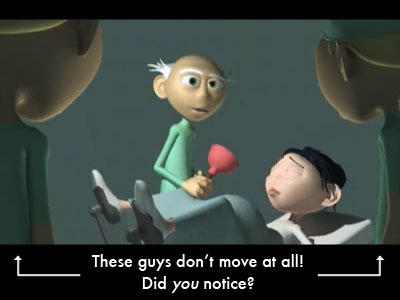
With the exception of the poor woman in the stirrups, we don't see any characters' feet--particularly Dr. Plunger. When you're animating a character walking, but their feet are out of frame, do you animate the feet at all?
I do animate feet all the way to the toes because it's hard for me to evaluate the body mechanics if the feet don't move correctly. It doesn't really take that much time. Once the body has been animated, it's basically just figuring out where the feet should be beneath the character. If I do cut corners somewhere, I may just not key as much as I normally would. The important thing is not to get too caught up with things that will never be seen.
We always like to hear insights into an animator's process. In past interviews you've told us about how you approach your animation. This time around, I think it would be interesting to hear about process ideas that you've tried to incorporate into your workflow before deciding that they simply didn't work for you. Have you had any experiences like that?
I feel a little hesitant admitting it in public but, I never really embraced the pose-to-pose method of animation. It goes back to the belief I have that computer animation lies somewhere between live-action film making and hand-drawn animation. The common approach is to place computer animation in the "animation" category and approach the task much like animation has always been done: starting pose-to-pose. But I like to think of computer animation more like live action, or maybe even live theater, where people don't always get into that "perfect pose." Generally I work in a straight ahead/layered method, but I will admit that it's a way of working that comes from lots of practice. You still must be aware of making strong poses, but my main emphasis is always more concerned with the motion first. As a result I think my motion is always pretty polished even when my posing might not be as strong.
When I started AnimationMentor they taught pose-to-pose, and while I was student, I tried to incorporate the method into my way of working, but I found I animated faster if I could just animated straight ahead and do the poses and breakdowns at the same time in one pass. For me that is the best way to work on my own projects. If however, I do work for someone else's approval, I work more pose-to-pose for their benefit.
This is your third eCritique prize from the 11 Second Club. Have you found that the animators you're working with now are as critical of each others' work as they are when critiquing an 11 Second Club piece?
In many ways, for better or worse, I'm probably the most critical person you'll ever meet, so I think my work is generally always acceptable. But what I value from other animators is their perspective, because it is too easy to get attached to what you're working on and completely miss what isn't working, or miss something you can do to make it better. I know of several instances where I animated something and showed it to someone, only to have their interpretation completely different than what I had intended.
For that matter, can you share anything about your experience of Dailies at Rhythm and Hues? Is it like an eCritique at all?
The difference between eCritiques and dailies is that the eCritiques focus on fixing things related to animation principles in general. Since the animation is yours, there aren't really all that many comments about specific acting choices you make. In dailies, the comments are more about fixing what doesn't work in context of the film, or about changing things that simply may not be liked. In a way, dailies are much easier because the work isn't yours. If you come up with some cool animation and the person signing your paycheck doesn't like it, regardless of how cool it is, it has to be changed. It's just personal preference. When you do work on your own and it isn't liked, it's much more personal.
The other way eCritques differ from dailies is the recommendations in the eCritiques are suggestions, and it's up to you to decide whether or not to listen to them. Most of the suggestions are worthwhile, and you'd have to be pretty arrogant to completely disregard the advice of the mentors, but occasionally something might be said that you disagree with, and you have to decide whether to trust your beliefs, or blindly follow what is being said. In dailies, if there's a "suggestion," even if you disagree, it has to be done.
Have you been able to go back to any of your winning entries and polish them based on the notes in your eCritiques?
Here are the changes to the first two wins:
(note: these movies can also be viewed, along with upcoming changes to the November entry, at Tim's web site)
Is there anything you'd like to add about your experiences throughout all of the time you've been entering 11 Second Club competitions up until the time you got a job?
After you graduate from AM, you're left with a decent demo reel, and a lot of free time. You go through AnimationMentor withdrawal. It was nice to have someplace to go and give me the necessary motivation to keep working. Just knowing that the animation I made was going to be seen by other animators and rated made me try very hard. I think I improved a lot in the six months that I was competing, and I know that the work I did for 11 Second Club was instrumental in getting my job.
You've mentioned that this will be the last competition you enter for a while. Do you have any parting words, or thoughts of encouragement to anyone who would like to follow in your Three-Time-Winner footsteps?
I still advise you to do as much animation as you can. Because of my schedule, I was only able to find about 3 hours a day to animate, but that time adds up quickly. Even if you don't think you're getting better, you will absolutely will be getting faster. The faster you can work, the more animation you can produce, and in turn the better you will get, and so on, and so on. Like most things, it has nothing to do with natural talent or ability, is has everything to do with practice, and perhaps a little luck.
- Tim Granberg
Discuss this interview in the forums
comments powered by Disqus






